|
I was beginning to feel guilty about gawking at a raptor instead of a report, so back inside I went. Once there though I had to share, so in seconds I had an entire neighborhood of cube people peepin out the window to check out the hawk in a tree.
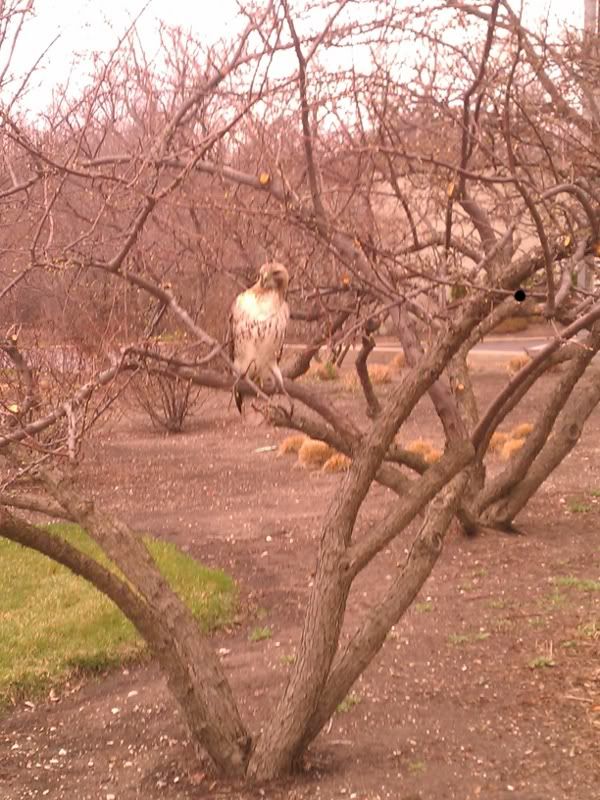
After chatting a bit I started a search for Illinois hawks to determine what species it was, although I was fairly certain it was a red-tailed hawk. That led me to A Pictoral Guide to Illinois Birds
There are a quite a few birds of prey in Illinois.
| Rough-legged hawk (Buteo lagopus) |
| This is a broad-winged raptor, typical of the genus Buteo. Compared to the Common Buzzard, it is longer-winged and more eagle-like in appearance. Its feet are feathered to the toes (hence its scientific name, meaning “hare-footed”) as an adaptation to its arctic home range. Its toes are short for its size.Wiki |
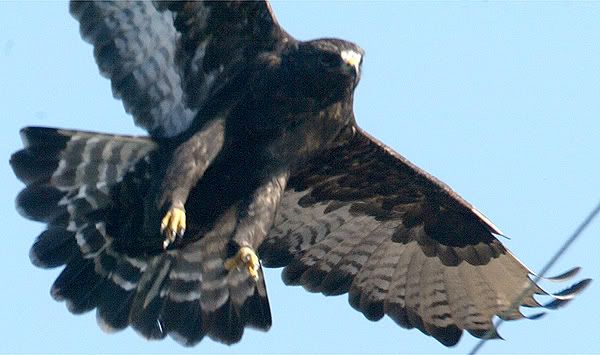 |
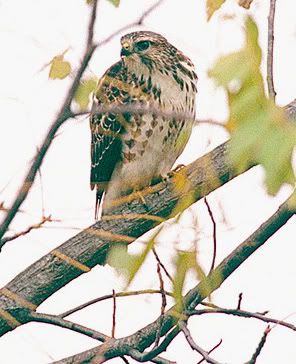 |
The Broad-winged Hawk (Buteo platypterus) is a small hawk of the Buteo genus. During the summer they are distributed over most of eastern North America, to as far west as the Alberta province and Texas; they then migrate south to winter in the neotropics from Mexico down to Southern Brazil. Many of the subspecies in the Caribbean are endemic and most do not migrate.
Adult birds range in size from 34 to 45 cm (13 to 18 in), weigh from 265 to 560 g (9.4 oz to 1.2 lbs) and have a wingspan from 81 to 100 cm (32 to 40 in). As in most raptors, females are slightly larger than males. Adults have dark brown upper parts and evenly spaced black and white bands on the tail. Broad-winged Hawks’ wings are relatively short and broad with a tapered, somewhat pointed appearance unique to this species.Wiki |
| Red-shouldered Hawk (Buteo lineatus) |
| Males are 43 to 58 centimetres (17 to 23 in) long, weigh about 550 g (19 oz) (1.2 lbs) and have a wingspan of 96 cm (38 in). Females are slightly larger at 48 to 61 cm (19 to 24 in) in length, a weight of about 700 g (25 oz), and a wingspan of about 105 cm (41 in). Adults have brownish heads, reddish chests, and pale bellies with reddish bars. Their tails, which are quite long by Buteo standards, is marked with narrow white bars. Red “shoulders” are visible when the birds are perched. These hawks’ upper parts are dark with pale spots and they have long yellow legs. Western birds may appear more red, while Florida birds are generally paler. The wings of adults are more heavily barred on the upper side. Juvenile Red-shouldered Hawks are most likely to be confused with juvenile Broad-winged Hawks, but can be distinguished by their long tails, crescent-like wing markings, and a more flapping, Accipiter-like flight style. This bird is often confused with the Red-tailed Hawk. Wiki |
 |
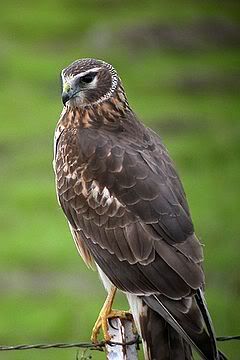 |
The Hen Harrier (Circus cyaneus) or Northern Harrier (in North America) is a bird of prey. It breeds throughout the northern parts of the northern hemisphere in Canada and the northernmost USA, and in northern Eurasia. This species is polytypic, with two subspecies. Marsh Hawk is a historical name for the American form.
It migrates to more southerly areas in winter. Eurasian birds move to southern Europe and southern temperate Asia, and American breeders to the southernmost USA, Mexico, and Central America. In the mildest regions, such as France, Great Britain, and the southern US, Hen Harriers may be present all year, but the higher ground is largely deserted in winter.Wiki |
| Cooper’s Hawk (Accipitercooperii) |
| The average size of an adult male ranges from 280 to 350 g with a length between 35 and 46 cm. The adult male is significantly smaller than the average female, which are 440 to 570 g and 42 to 50 cm long. Individuals living in the eastern regions tend to be larger and heavier than those in the western regions. All have short rounded wings and a very long tail with dark bands, round-ended at the tip. Adults have red eyes and have a black cap, with blue-gray upper parts and white underparts with fine, thin, reddish bars. Their tail is blue gray on top and pale underneath, barred with black bands.Wiki |
 |
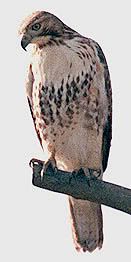 |
The Red-tailed Hawk (Buteo jamaicensis) is a bird of prey, one of three species colloquially known in the United States as the “chickenhawk,” though it rarely preys on chickens. It breeds throughout most of North America, from western Alaska and northern Canada to as far south as Panama and the West Indies, and is one of the most common buteos in North America. Red-tailed Hawks can acclimate to all the biomes within its range. There are fourteen recognized subspecies, which vary in appearance and range. It is one of the largest members of the genus Buteo in North America, typically weighing from 690 to 1600 grams (1.5 to 3.5 pounds) and measuring 45-65 cm (18 to 26 in) in length, with a wingspan from 110 to 145 cm (43 to 57 in). The Red-tailed Hawk displays sexual dimorphism in size, with females averaging about 25% heavier than males.Wiki |
I wanted to take some pictures and, since the bird seemed to be amused by the humans traipsing up and back, he was still there when I got back with my new fangled phone. From the top floor I’d noticed a patch of color that, from there, I thought odd, but now as I moved around to snap a profile that the bird I saw that the bird had been tagged-090. Of course, that boded ill for my reports, raptors were the first order of business now, so back to the intertubes.
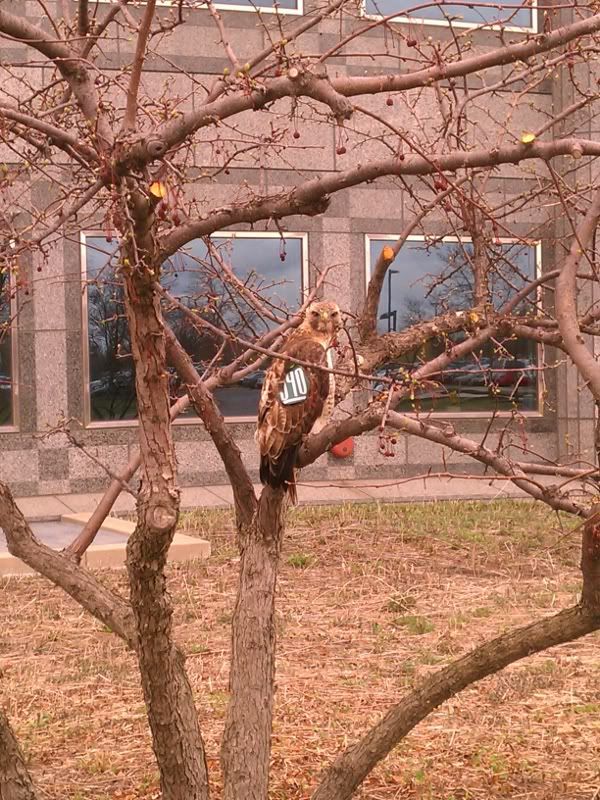
I searched for banded red-tailed hawks. I ran across this article
| Red-tailed hawk seen on U of I campus subject of O’Hare study |
Back on the morning of January 21st, I was dutifully pecking away at my keyboard when I got a phone call from a coworker one floor below. “Quick,” she gasped, “clook outside, there’s a huge bird!” I was at the window in a flash, and there, perched atop the nearest streetlight, was a first-year red-tailed hawk. Now, a red-tailed hawk is an everyday bird in Illinois, and I wouldn’t mention this one had it not been for something I noticed as I photographed it; it was wearing on its wings great big tags, marked with the number 80.
|
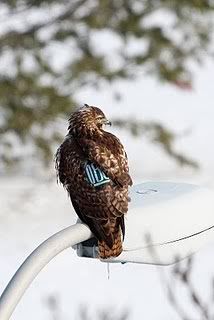 |
Snap! I named that bird song in two googles 🙂 I’ll have the actual study in 3! red-tailed hawk o’hare study and I had it: Tagged red-tailed Hawks released near O’Hare – please report sightings
To: Birding Groups
Subject: Red-tailed Hawk Research
Date: 10/19/2010
USDA APHIS Wildlife Services (WS) and the National Wildlife Research Center have started a mark/re-sighting study on red-tailed hawks as part of the ongoing efforts to find non-lethal solutions to wildlife issues at airports.
For the mark/re-sighting study, we are marking roughly 200 birds/year for the next three years and relocating them 50, 75, 100, and 125 miles due west of a major airport in the Chicago region. This year the tags are green with white numbers ranging from 000 to 200. Next year (2011) they will be white with black numbers 000 to 200, and the following year (2012) orange with black numbers 000 to 200. We want to see if there is a difference in the return rates of the birds back to the airport, depending on how far away from the airport we move them. These birds will also be fitted with a metal USGS leg band.
If anyone observes these birds, please feel free to contact Craig Pullins (craig.k.pullins@aphis.usda.gov) at (773) 686-6742 or Travis Guerrant (travis.guerrant@aphis.usda.gov) at (773) 686-6955. If possible, time, date and GPS location would be greatly appreciated, but any information you can provide would be helpful.
Thank you,
Travis Guerrant Wildlife Biologist, IL Wildlife Services
That evening I sent Craig and Travis an email including the 3 pictures I took and asked for the particulars for 090. Craig Pullins kindly replied…
Mike,
Thank you for the info and the pictures, it is very interesting for us to hear about where these birds are hanging out. The bird you spotted is part of a study being conducted at O’Hare Airport in Chicago to determine if relocation distance from the airport has any influence on the return rate of these birds back to the airport. We just finished our first year of the study and plan to continue it for at least the next 2 years. The bird you saw looks to be #90 and it was originally caught on 9/29/10 at ORD and was relocated to a state park in Whiteside County. You might be interested to read the article published in a newspaper in Champaign about the study (the story mentioned above).
I was interested in some other statistics and where exactly 090 was released, so I sent Craig another email. He said that they didn’t weigh or determine the sex of the captured hawks and that they released 090 in Morrison-Rockwood State Park in Whiteside County about 100 miles from O’hare airport.
That was my science adventure this week. I wonder what might be next. Thanks for giving this a read.
|
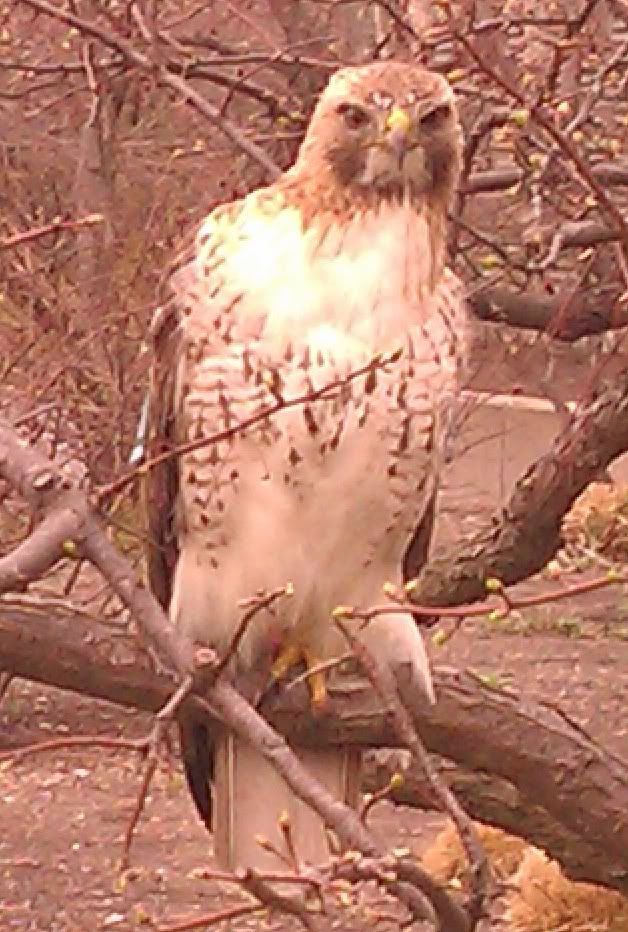










5 comments
Skip to comment form
Author
🙂 Hi Ek. Hope your doing well.
We have our share of hawks and falcons. I live in between two large parks that is the flyway for a red tailed hawk who likes to use my backyard as his banquet table for his dinners. The Verrazano-Narrows Bridge has long been a nesting place for peregrine falcons and their nests are protected.
They are beautiful birds and #90 is very handsome.